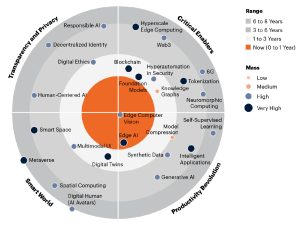Industry
4 emerging technologies disrupting the next 3-8 years

Four emerging technologies and trends need to be considered to which tech vendors and product leaders will need to respond, calibrating their tech strategies, investments, and tools to stay ahead:
Smart world expands with increased fusion of physical–digital experiences.
Productivity revolution accelerates with advances in artificial intelligence (AI) tools and tech.
Transparency and privacy get more scrutiny amid exponential growth in corporate and personal data collection.
New critical technology enablers create new business and monetization opportunities.
Neuromorphic computing will disrupt many current AI technology developments
Most of this year’s emerging technologies and trends are three to eight years away from reaching widespread adoption, but represent significant innovation in the years ahead.
Emerging technologies and trends

Range measures number of years. It will take the technology/trend to across over from early adopter to early majority adoption. Mass indicates how substantial the impact of the technology or trend will be on existing products and markets.
Let us look at four we think will prove especially interesting.
Neuromorphic computing
- A critical enabler, neuromorphic computing provides a mechanism to more accurately model the operation of a biological brain, using digital or analog processing techniques.
- It will take three to six years to cross over from early-adopter status to early majority adoption.
- Neuromorphic computing will have a substantial impact on existing products and markets.
Neuromorphic computing systems simplify product development, enabling product leaders to develop AI systems that can better respond to the unpredictability of the real world. Their autonomous capabilities quickly react to real-time events and information, and will form the basis of a wide range of future AI-based products. Early use cases include event detection, pattern recognition, and small dataset training.
We expect breakthrough neuromorphic devices by the end of 2023, but it will likely take five years for these devices to reach early majority adoption.
The impact is likely to be significant, though, as neuromorphic computing is expected to disrupt many of the current AI technology developments, delivering power savings and performance benefits not achievable with current generations of AI chips.
Self-supervised learning
- Self-supervised learning accelerates productivity by using an automated approach to annotating and labeling data.
- It will take six to eight years to cross over from early-adopter status to early majority adoption.
- Self-supervised learning will have a significant impact on existing products and markets.
Self-supervised models learn how information relates to other information; for example, which situations typically precede or follow another, and which words often go together.
Self-supervised learning has only recently emerged from academia and is currently practiced by a limited number of AI companies. A few companies focused on computer vision and NLP products have recently added self-supervised learning to their product roadmaps, however.
The potential impact and benefits of self-supervised learning are extensive, as it will extend the applicability of machine learning to organizations with limited access to large datasets. Its relevance is most prominent in AI applications that typically rely on labeled data, primarily computer vision and NLP.
Metaverse
- The metaverse fuels the smart world by providing an immersive digital environment.
- It will take eight-plus years to cross over from early-adopter status to early majority adoption.
- The metaverse will have a very substantial impact on existing products and markets.
The metaverse enables persistent, decentralized, collaborative, interoperable digital content that intersects with the physical world’s real-time, spatially organized, and indexed content.
It is an example of a combinatorial trend, in which a number of individually important, discrete, and independently evolving trends and technologies interact with one another to give rise to another trend. The emerging, supporting technologies and trends include (but are not limited to) spatial computing and the spatial web; digital persistence; multi-entity environments; decentralization tech; high-speed, low-latency networking; sensing technologies; and AI applications.
The features and functionality these ETT bring to the metaverse will need to reach an early majority in order for the metaverse to cross the chasm. We consider all current examples to be precursors or premetaverse offerings because they are potentially capable and compatible, but do not yet meet the definition of the metaverse.
While the benefits and opportunities from the metaverse are not immediately viable, emerging metaverse solutions give an indicator of potential use cases. We expect the transition toward metaverse to be as significant as the one from analog to digital.
Human-centered AI
- Human-centered AI (HCAI) is a common AI design principle, calling for AI to benefit people and society, which could improve transparency and privacy.
- It will take three to six years to reach early majority adoption.
- HCAI will have a substantial impact on existing products and markets.
HCAI assumes a partnership model of people and AI working together to enhance cognitive performance, including learning, decision making, and new experiences. HCAI is sometimes referred to as augmented intelligence, centaur intelligence, or human-in-the-loop, but in a wider sense, even a fully automated system must have human benefits as a goal.
HCAI enables vendors to manage AI risks, and to be ethical, responsible, and more efficient with automation, while complementing AI with a human touch and with common sense. Many AI vendors have already shifted their positions to the more impactful and responsible HCAI approach. The technology-centric approach of developing AI products has led to numerous negative impacts, urging vendors to rethink their AI product strategies.
The potential impact of HCAI is high because it leverages human abilities to make humans more productive, and remove avoidable limitations, biases, and blind spots.













You must be logged in to post a comment Login